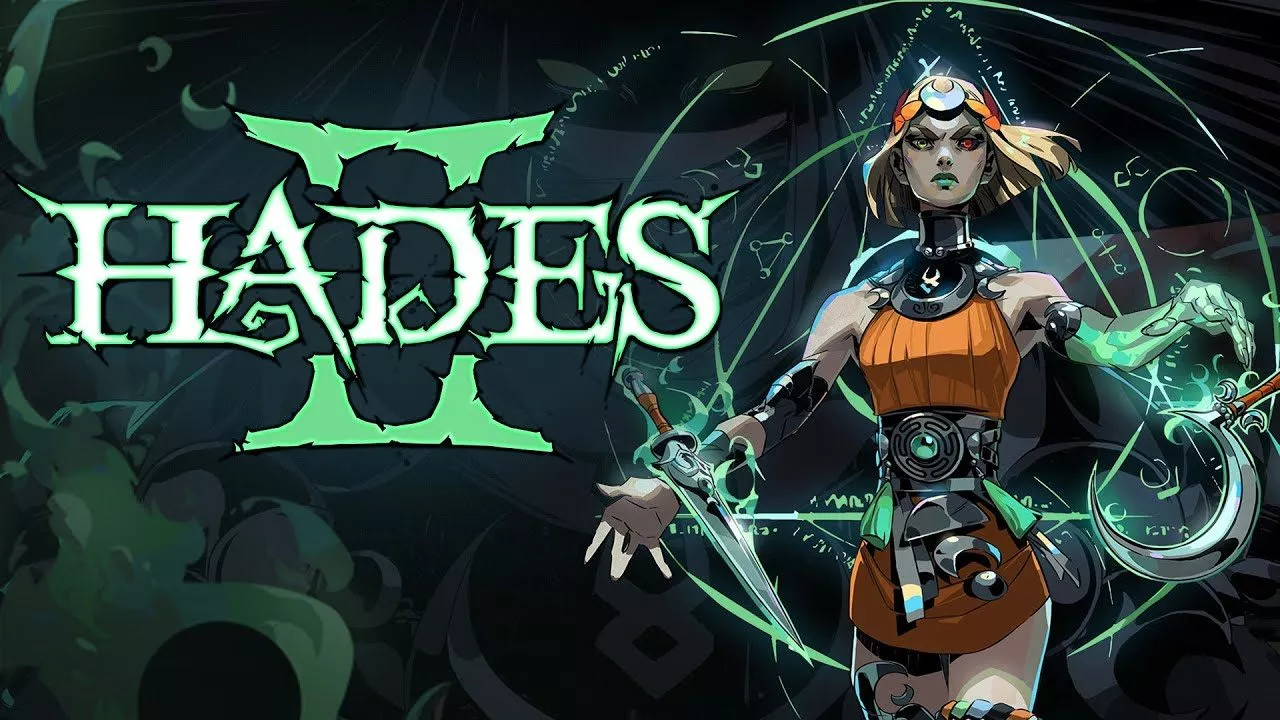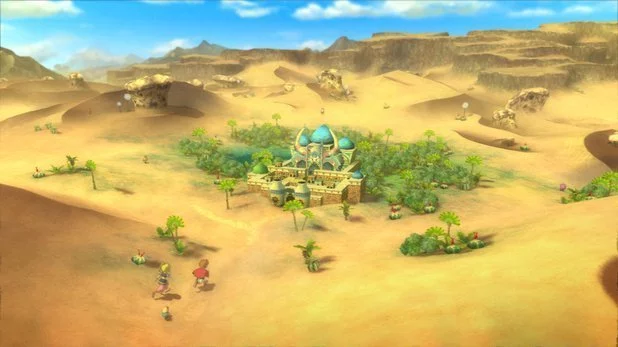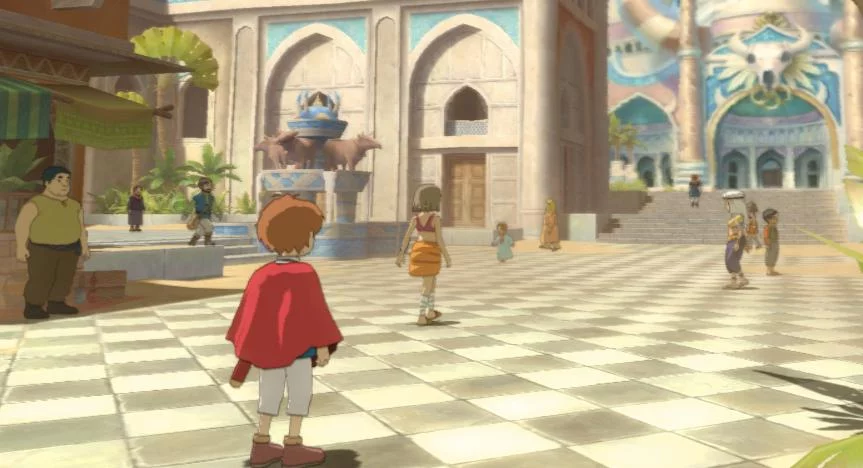If there’s one thing that’s immediately striking about Level 5’s Ni no Kuni (literal translation: Second Country, but this can be translated in multiple ways), and that’s how darned gorgeous it looks. Developed in tandem with Studio Ghibli — yes, THAT Studio Ghibli, the animators behind such gems as Spirited Away and My Neighbor Totoro — there is a level of quality and attention to detail that is almost literally second to none. Certain cutscenes are entirely anime, while the in-game engine has been developed to mimic this style as closely as possible — and it looks wonderful. In addition, the music was scored by legendary Joe Hisaishi himself (known for his work with Studio Ghibli movies), and ebbs and flows throughout the narrative, which really defines an epic experience – never before has a videogame managed the kinds of feelings that Ni no Kuni evokes, and it comes highly recommended to fans of Japanese animation.
Ni no Kuni is a Japanese RPG set in a fantasy reality. The narrative follows a young boy named Oliver, whose mother is taken from him early in the game (this is not a spoiler — it is the driver behind the adventure). His tears bring a much-loved toy to life — a character known in-game as Drippy, High Lord of the Fairies, and it is he that takes Oliver into Ni no Kuni – “A whole ‘nother World” — a second dimension, if you will, parallel to Oliver’s own, on an adventure to try to save his mother’s life, as well as the fate of Ni no Kuni itself.
The story is simple for what it is, and provides a touching impetus to get players started on what is a lengthy road — around 40 hours in total, side quests notwithstanding. From these strong beginnings, the story follows mostly standard RPG narrative — the “big bad” ( the titular White Witch) entrusts an evil servant to bring about Oliver’s demise, while the protagonist travels from town to town gathering the requisite components to take them down. Each major plot point will pit players against a boss character, and player abilities and party size increase as the game progresses.
And Oliver does meet many interesting characters throughout the game — both within his hometown of Motorville and in Ni no Kuni itself — but only two of those characters spend the majority of the game to aid him in his plight. Where the game does differ from others in the same genre is in the collection and utilisation of “familiars” — essentially, these are captured creatures that can be tamed and employed in battle. Not unlike Pokemon, to be honest. Each party member can utilise three familiars in battle, each of which has a certain affinity to an astronomical entity (Sun, Moon, Planet, Star). In this way, they have access to different kinds of magic, and have specific pros and cons against other creatures, depending on their ‘sign’. There are apparently over 400 different familiars in the game (although some of these may be upgraded versions of a certain familiar), making mastering this aspect quite a challenge in itself.
Familiars can be fed in the “creature cage” — certain sweets will provide attribute bonuses, and sweets aligned to astronomical types can morph familiars in to stronger versions when they reach a certain level. This can be performed on two occasions, the second upgrade providing a choice as to what particular strengths players would like their familiar to have. As a result, with so many characters receiving XP bonuses following combat sessions, it could be expected that levelling would get out of hand. Luckily, the developers have found a way around this, and simplified the amount of player interaction that is required. Some basic item and spell swapping is all that is required overall, with detailed management of familiars best left to the more hardcore players.
Combat is fairly standard JRPG fare. Players control a party of up to three characters, as mentioned earlier, each of which have their own special abilities and magical capabilities. Tactics can be applied to provide supporting characters with specific roles (keeping the others healthy, for example), but players can only ever have direct control over one character at any given time — and yes, this includes familiars. This means that, while you have a party of three, and each character has control over three familiars, only three characters are in the fight at a time. To some degree, this limits crazy party juggling, but it also means that switching characters can cancel actions, which is frustrating. Given that actions are selected from a wheel of speech bubbles as opposed to a more organised list, managing a party is frustrating most of the time, to be honest.
Beyond combat, though, there is a very deep focus on lore and crafting. Oliver discovers the “Wizard’s Companion” very early in the game. Essentially, this book carries all the information that Oliver requires, from spells and short stories covering Ni no Kuni lore, through to Alchemical formula and descriptions of enemies encountered in game. It is extremely detailed — a physical version of the book exists and is said to weigh in at 300+ pages (this was sold only with the Special Edition of the game. Consider yourself very lucky if you managed to score yourself a copy of that). Navigation of this book leaves a lot to be desired – there’s a lot of zooming in and out to find a particular piece of information – but the book overall looks to be a labour of love on its own, as the detail is extraordinary.
A little later in the game, Oliver also becomes the proud owner of a cauldron — replete with Aladdin-style Genie. Once he has this, he can then craft his own food, portions, weapons, shields and so on – provided he has the right ingredients. What could have been a FANTASTIC addition to the game ends up falling flat — tracking down the right ingredients is not always easy, and having to flick through the Wizard’s Companion every time you want to create something doesn’t help either. The issue here is that once you mix-and-match the right ingredients to create an item, the formula is NOT saved in a formula list – you have to look it up every time. You are GIVEN various formula from time to time, and these are the only ones stored in your list. Seems like an oversight to me. For this reason, I found myself buying components more often than I made them. If the system was more like Skyrim, I would have been in love.
The characters themselves are sublime. Oliver, while just a kid, is endearing, and Drippy is just downright HILARIOUS. In fact, the game is amusing from start to finish (not always, of course, but there are a lot of good laughs). Character design is a mixture of standard Ghibli and JRPG styles, and it’s absolutely charming. Level 5 has also clearly placed a high degree of focus on localisation and voice acting, as both are superb (warning: prepare for animal puns, as they come at you thick and thin). Drippy has a very strong Welsh accent, and it absolutely suits the character to a tee. Bravo.
Of course, you might like to change the audio to Japanese, and appreciate the game the way it was originally created, with English subtitles. In general, this is how I tend to watch Japanese anime, and it really works here as well, but I must say, if you don’t understand Japanese, you really are missing some great English voice acting. It’s a tough choice for most, but given I do understand Japanese (to some degree), I enjoyed my choice immensely. Although… It was strange that I found some translations to be so very different (and I’m not referring to jokes, here, which don’t transcend language at the best of times, I’m referring to names — one of Oliver’s friends, for example, is named Phil in the English version, and Mark in Japanese. I don’t quite understand why).
In many ways, attention to detail is what best describes Ni no Kuni overall — from the detail in the environments and characters, to the way Oliver’s cape flutters as he moves, to the water animations of the ocean (yes, you do find yourself a ship and travel the seas, among… other forms of transportation), the game exudes perfection. Well… at least in terms of presentation.
There are a number of problems with the gameplay, however, that can not be overlooked. For one, the grind is PAINFUL (and yes, I know this is a JRPG, and the Japanese like grinding). Enemies are abundant, and XP is paid out frugally. Combat is enjoyable, so it’s not a major issue, but the problem comes down to the HUGE leaps in difficulty. Players need to be a certain level before they tackle certain bosses, and the game does not let you know this until it hands you your ass repeatedly. Then it’s back to the grind.
Of course, if you had the right equipment…? Well, sure. But the game doesn’t really balance this well either. For example, gold is fairly hard come by early in the game. Grinding from town to town might net you 2000 guilders (the in-game currency), but a single weapon might cost 2500. And how about potions? Health potions are well priced and easily come by, by mana potions are a nightmare. A cup of coffee costs 200 guilders, and only replaces 10 MP — considering many spells cost this much or more, it is a very expensive option… But some bosses REQUIRE you to use a lot of spells to take them down, so you need to have a hell of a lot of money on hand before you prepare for a big boss battle. Clearly, the game has been designed this way deliberately, to force the grind. In my opinion, too much emphasis has been placed on grinding, and not enough on getting other aspects right. This is not such an issue from around halfway through the game, but seeing it takes 15-20 hours get even THAT far, it has a big impact on initial playability.
Further, and building upon the party management issues during combat (which I touched on briefly before) — there is no way to issue a single, overarching command to all party members (there is an option for “All-out Attack” and “All-out Defence” but these don’t immediately force a single action). In this way, players need to scroll through the action wheel to find “defend” for each character to tell them – individually – to defend against an incoming attack. This is a major problem, as some bosses move very quickly, but have pretty clear warm ups before they perform a special move (not to mention the fact that each action, including “defend,” is timed). Certain boss attacks can take up to half of a characters HP, but given the lack of party commands, you can only protect one member at a time. And considering only one representative of each character can be controlled at a time, you can not set your familiar to attack a boss while you chug down a potion. All of this together means it’s sometimes just too damned hard to juggle everyone’s abilities while monitoring their HP as well as their MP, and difficult bosses are EXTRA tough. For some, this is standard for JRPGs, and there may be some of you out there that consider this a challenge. But for me? I have too many games, and not enough time, and it was a pretty big impediment to my continued play.
Then there’s the strange side quests. Some are simple and have you tracking down items, but others rely on spells you learn. There are so many spells in this game, and quite a few puzzles, but Drippy will tell you what to do every time. It just seems like some spells are given to you just so that you can complete a couple of side quests, which is strange to me (there are some spells I’m sure I only used once). On top of this, there’s the idea that some NPCs are “broken hearted” — that is, a piece of their heart has been taken away from them. So you need to look for NPCs with EXTRA heart to fill that need (heart is made up of 8 “emotions”, including enthusiasm, happiness, restraint, etc.). I guess it adds a different element to the game, but it felt a little lifeless. NPCs with extra heart are clearly highlighted on the map, for example – there just isn’t a puzzle element to this addition. I guess it felt to me like there were some grand ideas that didn’t scale well into the overall product.
That said, though, there are a LOT of side quests, if that’s your thing. Each town has a few, some quests taking only a few minutes, while others may take an hour of your time. There is a merit card system that can provide additional bonuses, hidden treasure boxes that can be sought out, additional dungeons and environments that don’t come into play in the main story — the game is huge. When I first started, the world looked so small — but it opens up in sections, and when you finally open the world map, the true size becomes apparent, and it was alarming (in a good way). And of course, in true JRPG style, just when you think you’ve found the item you’ve been searching for the whole game, you’re told of several OTHER parts that are spread around the world, and each guarded by some sort of magical being. It’s a big game, granted, but there are so many cool little storyline elements to drive players through the grind.
And that’s just it — even given the painful amount of grinding, the poor combat design, and the strangely under-developed side quests, Ni no Kuni is just so damned charming that it would be a shame to miss. As a video game on its own, it can be fairly hit-and-miss, but in terms of story and presentation, it is one of the best experiences I’ve had of late. If Ni no Kuni spawns a sequel, and Level 5 takes the time to iron out some of the issues? They’ll have a huge hit on their hands. As it stands, Ni no Kuni may not get the attention it deserves.
Review
 |
The good |
The bad |
Want to know more about our scoring scale?
This article may contain affiliate links, meaning we could earn a small commission if you click-through and make a purchase. Stevivor is an independent outlet and our journalism is in no way influenced by any advertiser or commercial initiative.



























